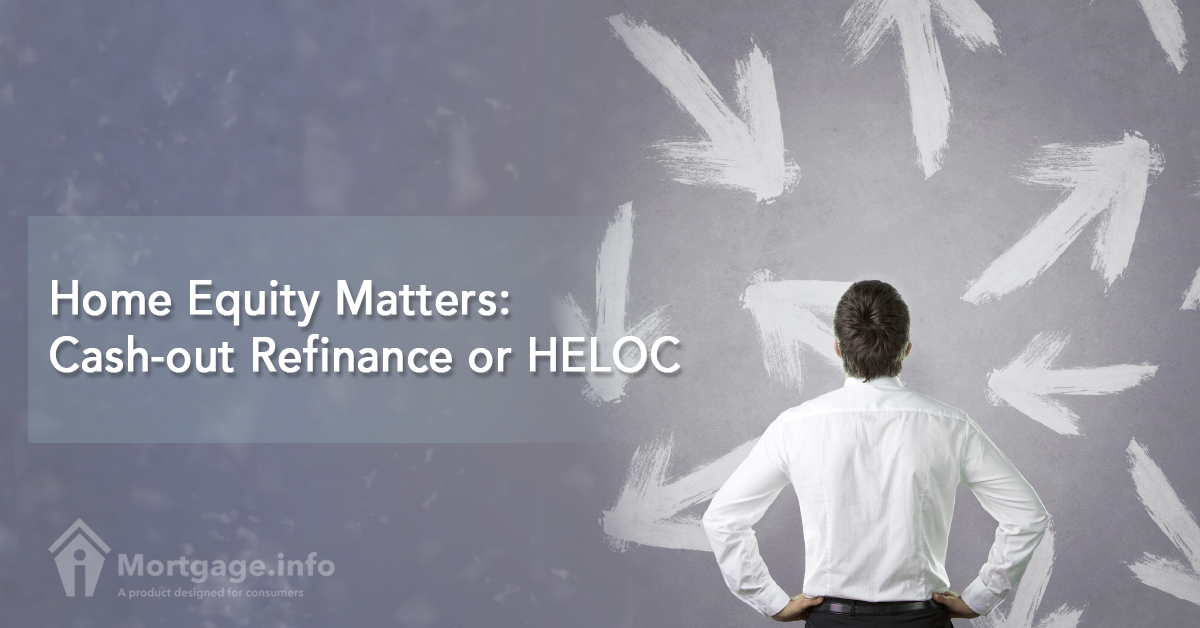Your home contains an important source of funds that you can tap however you want, your home equity. Both cash-out refinance and home equity line of credit allow you to do that but offer differing ways to accomplish that goal. How would you like to receive your equity: in cash through a refinance or a line of credit by way of a second mortgage? Which sounds better to you? Let’s find out here.
Choosing Between Cash-out Refinance and HELOC
Before you make a decision and settle for one option, think of how much home equity you have. Then, how do you want to make use of that equity? Should you refinance to get cash out, save money, or do both? Or you just need your equity as a standby source of fund?
If you have an answer to those questions, it’s about time to look into the features of both cash-out refi and HELOC from their definition to repayment.
1. Definition
2. Purpose
3. Rate (and Costs)
4. Qualification
5. Repayment
1. Definition
Cash-out refinance: You take out a new loan with (i) a larger amount (ii) at a lower rate preferably. Assuming you have a $150,000 home with $100,000 outstanding on your loan. You can apply to refinance for $130,000: $100,000 goes to the unpaid loan balance and pocketing the $30,000 in cash for whatever purpose you have in mind.
HELOC: You take on a second mortgage, which serves as your access to a line of credit. This LOC works like a credit card because it is a revolving debt. You can tap 80% to 90% of your home equity for the HELOC.
2. Purpose
Cash-out refinance: Its proceeds are used to consolidate and pay down debts, credit card balances especially. Even if you refinance to today’s rates of more than 4%, they are nothing compared to “low credit card rates” of say 12%. Funds can also be used for retirement, property repair/improvement, and even student loan repayment.
HELOC: It’s like your emergency fund for a given period of time. You have a draw period when you are allowed to take out and use these funds for whatever purpose. At closing, you must draw a certain amount called the minimum draw requirement and maintain an average loan balance throughout the life of the loan.
3. Rate (and Costs)
Cash-out refinance: Between a term-and-rate refinance where no pulling out of cash is involved and a cash-out refinance, rates vary. Usually, a cash-out refi has a higher rate compared to a normal refi. Fees have to be paid upfront although certain fees and closing costs can be financed into the loan.
HELOC: Between a cash-out refi and a HELOC, the latter comes with a higher rate. But because the HELOC is a variable interest rate loan, expect to have a lower initial rate. This can however adjust at some point, thereby increasing your monthly payments. A HELOC also has finance costs that needed to be paid upfront. Continuing costs like annual fees and transaction fees are paid throughout the loan term.
4. Qualification
Cash-out refinance: When you do a cash-out refinance, you go through the process of a typical purchase mortgage transaction. You will be assessed based on your credit, income, and the equity built into your home. The cash-out refi is an entirely new loan securing your home.
HELOC: It may require a lot of paperwork but the process itself is not as tedious as that of a typical mortgage application. Lenders will look into your equity, which forms the basis of the line of credit you can access; credit score; debt-to-income ratio; and employment history. The HELOC represents a second mortgage securing your home.
5. Repayment
Cash-out refinance: The cash proceeds are repaid and incorporated into a single monthly mortgage payment. Because cash-out refi loans are fixed-rate loans, payments are the same every month.
HELOC: HELOCs often have (i) a draw period, which is the time you are allowed to take out funds and (ii) a repayment period which is when you are required to pay back your loan.
The draw period can be the first five to 10 years of the loan. Then the repayment period of 10 to 20 years follows. The payment during the draw period can be lower because you can pay the interest portion only. When the repayment period starts, you have to pay the principal plus interest. The lender can change the terms of your loan, without prior notice.

